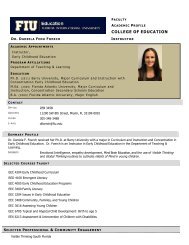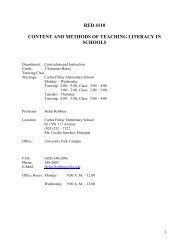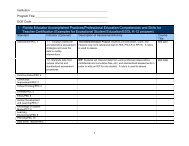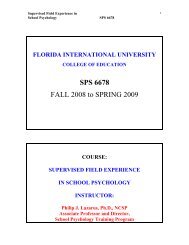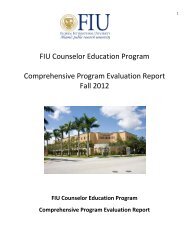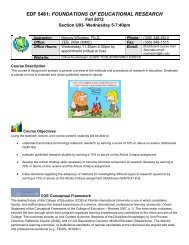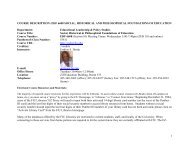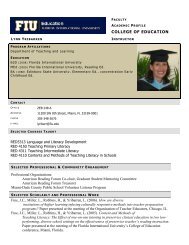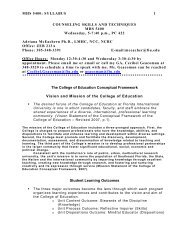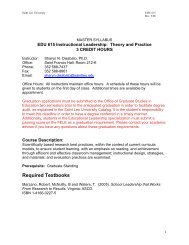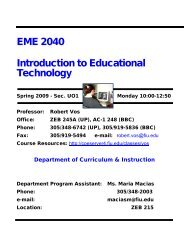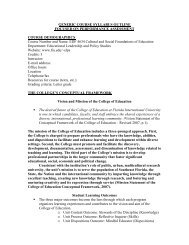2007 - College of Education - Florida International University
2007 - College of Education - Florida International University
2007 - College of Education - Florida International University
You also want an ePaper? Increase the reach of your titles
YUMPU automatically turns print PDFs into web optimized ePapers that Google loves.
ecause <strong>of</strong> the physiological metamorphosis they are undergoing, are primarily concerned with<br />
themselves. Accordingly, they fail to differentiate between what others are thinking and their<br />
own mental preoccupations. An antidote to egocentrism can be service learning. It is a powerful<br />
strategy for teaching and learning global education, which allows young people to deepen and<br />
demonstrate their learning and at the same time develop a strong sense <strong>of</strong> civic responsibility<br />
(Glenn, 2002).<br />
Challenges Facing the Community<br />
As stated before Dewey (1916) considers the community an integral part for creating a<br />
better learning environment in school, one that will perpetuate its culture. The school is a<br />
reflection <strong>of</strong> its community. Very frequently the community lives in isolation from its schools for<br />
many reasons, such as the lack <strong>of</strong> communication between schools and communities and the<br />
quality <strong>of</strong> communication. This challenge is reciprocal since both school and community need to<br />
find a common “meeting ground.” Service and community learning should be well received<br />
within a community and treated as an extension <strong>of</strong> the schools. The cliché “think locally, act<br />
globally” is doable but remains a challenge mainly from the lack <strong>of</strong> interest from the community<br />
itself or cooperation from those in power who can make it happen. Engaging the community in<br />
athletics within themselves and the “outside” world, celebrating their culture with the cultures <strong>of</strong><br />
the world, and opening their homes to exchange students from abroad and participating in global<br />
outreach programs are some ideas to make the global and local coincide.<br />
Choices for Teachers<br />
Choice is both desirable and empowering (Iyengar & Lepper, 1999). Teachers can make<br />
good choices only if they are knowledgeable about the local community and the world. An<br />
essential ingredient in making choices is “care” (Gaudelli, 2003). If teachers cared enough about<br />
the children upon whose minds they make an indelible mark, then maybe they would make the<br />
right choices. Teachers must choose books from other languages and cultures with guided<br />
discussions to help children develop an understanding <strong>of</strong> other people and their customs.<br />
Reading material can have a transformative effect and can become an important element <strong>of</strong> a<br />
global curriculum. Teachers can also be innovative in the development <strong>of</strong> extracurricular<br />
activities for extra credit or merely as relief from the drudgery <strong>of</strong> studying. Economics and<br />
mathematics lend themselves to a similar treatment - economics is a dynamic field, closely<br />
related to globalization and the functioning <strong>of</strong> global markets.<br />
Choices for Students<br />
Intrinsic motivation has provided the clearest demonstration <strong>of</strong> the link between the<br />
provision <strong>of</strong> choice and motivation (Iyengar & Lepper, 1999). The obvious lack <strong>of</strong> choices in the<br />
curriculum mandated by the state is detrimental to the global education <strong>of</strong> the student. Social<br />
studies is the most appropriate subject for launching global education, but because <strong>of</strong><br />
accountability, it has been side-stepped. If choices are <strong>of</strong>fered, students have opportunities to<br />
study content that can empower them to consider diverse and conflicting points <strong>of</strong> view. It can<br />
encourage them to think critically about their own identity and social construction. Teachers who<br />
provide experiential inquiry and collaborative learning (Pike & Selby, 1988) through choices<br />
help students learn from their own and other people’s experiences and feelings.<br />
Choices for the Community<br />
There is increasing recognition within developmental, educational, and sociological<br />
theories that both schools and home are important institutions that socialize and educate children.<br />
Most current theories stress the need for connections between families and schools (Epstein,<br />
1990). Polls <strong>of</strong> public opinion (Gallup, 1986), for example, have shown that parents want more<br />
15



